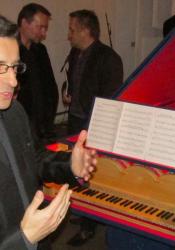Krakow, Poland
Polish instrument maker and concert pianist Sławomir Zubrzycki debuted his fully-functional viola organista, created based off of Leonardo’s drawings, at the 5th International Royal Krakow Piano Festival. This festival is the first cultural event dedicated to piano music to take place in Krakow, and the goal of the event is to attract elite pianists and encourage them to perform at this festival. Krakow is known to be the cultural capital of Poland, and houses the Academy of Music in Krakow, one of the oldest music higher education academies in Europe.
Zubrzycki, Sławomir. “Biography.” Viola Organista, 2015, www.violaorganista.com/en/slawomir_zubrzycki/biography/.
Parent Map
Coordinates
Latitude: 50.064650100000
Longitude: 19.944979900000
Longitude: 19.944979900000

